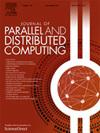OWL: Worker-assisted server bandwidth optimization for efficient communication federated learning
IF 3.4
3区 计算机科学
Q1 COMPUTER SCIENCE, THEORY & METHODS
引用次数: 0
Abstract
Edge computing in federated learning based on centralized architecture often faces communication constraints in large clusters. Although there have been some efforts like computation-communication overlapping and fine-granularity flow scheduling towards how to reduce the communication cost, this is still a matter of ongoing research. Motivated by the underutilization of bandwidth among workers (edge devices) and the replication of deep neural network (DNN) model distributions in data-parallel federated learning, we propose OWL, a novel worker-assisted server bandwidth optimization method. OWL partitions numerous computation branches into groups based on the model's network topology, allowing for overlapping model distribution and computation among workers, thereby leveraging idle communication resources on the workers to compensate for server bandwidth. To address the issue of model distribution congestion on the server, we formulate group partition as an optimization problem, which proves to be NP-hard. We tackle this problem through a divide-and-conquer approach employing an approximation grouping algorithm and a deploying algorithm. Finally, we evaluate the performance of OWL through simulations and a comprehensive real-world case study involving model training on OWL and deployment on edge systems. Experimental results demonstrate that OWL reduces overall training time by up to 20%-69% and improves scalability by over 9.5% compared to state-of-the-art overlapping approaches.
OWL:工作人员辅助的服务器带宽优化,用于有效的通信联合学习
基于集中式体系结构的联邦学习中的边缘计算在大型集群中经常面临通信约束。虽然在如何降低通信成本方面已经有了一些努力,如计算通信重叠和细粒度流调度,但这仍然是一个正在进行的研究问题。针对工作人员(边缘设备)之间的带宽利用率不足以及数据并行联邦学习中深度神经网络(DNN)模型分布的复制,我们提出了一种新的工作人员辅助服务器带宽优化方法OWL。OWL根据模型的网络拓扑将众多计算分支划分为组,允许在worker之间重叠模型分布和计算,从而利用worker上的空闲通信资源来补偿服务器带宽。为了解决服务器上的模型分布拥塞问题,我们将分组划分作为一个优化问题,这被证明是np困难的。我们通过采用近似分组算法和部署算法的分而治之的方法来解决这个问题。最后,我们通过模拟和全面的现实世界案例研究来评估OWL的性能,包括OWL的模型训练和在边缘系统上的部署。实验结果表明,与最先进的重叠方法相比,OWL将总训练时间减少了20%-69%,可扩展性提高了9.5%以上。
本文章由计算机程序翻译,如有差异,请以英文原文为准。
求助全文
约1分钟内获得全文
求助全文
来源期刊

Journal of Parallel and Distributed Computing
工程技术-计算机:理论方法
CiteScore
10.30
自引率
2.60%
发文量
172
审稿时长
12 months
期刊介绍:
This international journal is directed to researchers, engineers, educators, managers, programmers, and users of computers who have particular interests in parallel processing and/or distributed computing.
The Journal of Parallel and Distributed Computing publishes original research papers and timely review articles on the theory, design, evaluation, and use of parallel and/or distributed computing systems. The journal also features special issues on these topics; again covering the full range from the design to the use of our targeted systems.
 求助内容:
求助内容: 应助结果提醒方式:
应助结果提醒方式:


